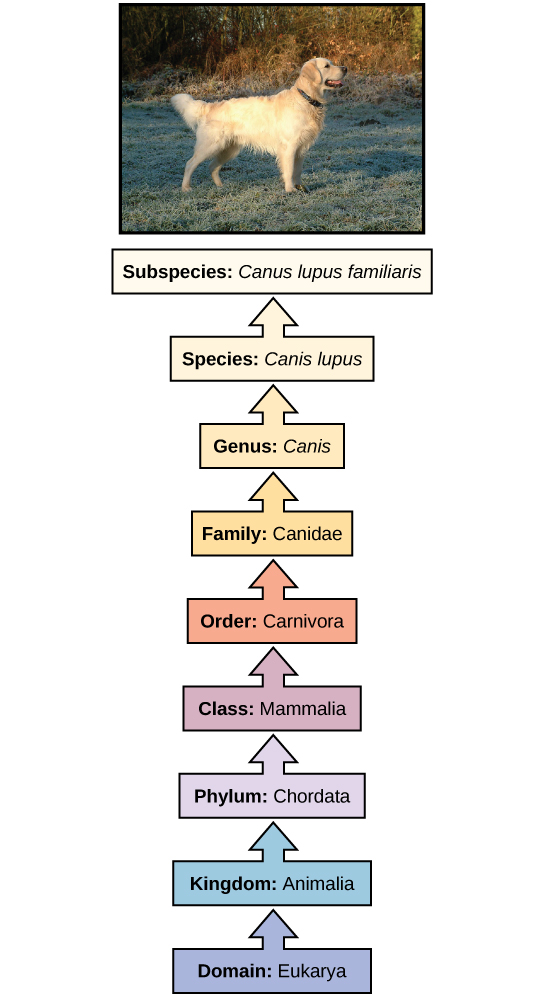7.6: Systematics and Classification
- Page ID
- 96547
\( \newcommand{\vecs}[1]{\overset { \scriptstyle \rightharpoonup} {\mathbf{#1}} } \)
\( \newcommand{\vecd}[1]{\overset{-\!-\!\rightharpoonup}{\vphantom{a}\smash {#1}}} \)
\( \newcommand{\id}{\mathrm{id}}\) \( \newcommand{\Span}{\mathrm{span}}\)
( \newcommand{\kernel}{\mathrm{null}\,}\) \( \newcommand{\range}{\mathrm{range}\,}\)
\( \newcommand{\RealPart}{\mathrm{Re}}\) \( \newcommand{\ImaginaryPart}{\mathrm{Im}}\)
\( \newcommand{\Argument}{\mathrm{Arg}}\) \( \newcommand{\norm}[1]{\| #1 \|}\)
\( \newcommand{\inner}[2]{\langle #1, #2 \rangle}\)
\( \newcommand{\Span}{\mathrm{span}}\)
\( \newcommand{\id}{\mathrm{id}}\)
\( \newcommand{\Span}{\mathrm{span}}\)
\( \newcommand{\kernel}{\mathrm{null}\,}\)
\( \newcommand{\range}{\mathrm{range}\,}\)
\( \newcommand{\RealPart}{\mathrm{Re}}\)
\( \newcommand{\ImaginaryPart}{\mathrm{Im}}\)
\( \newcommand{\Argument}{\mathrm{Arg}}\)
\( \newcommand{\norm}[1]{\| #1 \|}\)
\( \newcommand{\inner}[2]{\langle #1, #2 \rangle}\)
\( \newcommand{\Span}{\mathrm{span}}\) \( \newcommand{\AA}{\unicode[.8,0]{x212B}}\)
\( \newcommand{\vectorA}[1]{\vec{#1}} % arrow\)
\( \newcommand{\vectorAt}[1]{\vec{\text{#1}}} % arrow\)
\( \newcommand{\vectorB}[1]{\overset { \scriptstyle \rightharpoonup} {\mathbf{#1}} } \)
\( \newcommand{\vectorC}[1]{\textbf{#1}} \)
\( \newcommand{\vectorD}[1]{\overrightarrow{#1}} \)
\( \newcommand{\vectorDt}[1]{\overrightarrow{\text{#1}}} \)
\( \newcommand{\vectE}[1]{\overset{-\!-\!\rightharpoonup}{\vphantom{a}\smash{\mathbf {#1}}}} \)
\( \newcommand{\vecs}[1]{\overset { \scriptstyle \rightharpoonup} {\mathbf{#1}} } \)
\( \newcommand{\vecd}[1]{\overset{-\!-\!\rightharpoonup}{\vphantom{a}\smash {#1}}} \)
Systematics and Classification
- Please read and watch the following Mandatory Resources
- Reading the material for understanding, and taking notes during videos, will take approximately 45 minutes.
- Optional Activities are embedded.
- To navigate to the next section, use the Contents menu at the top of the page OR the right arrow on the side of the page.
- If on a mobile device, use the Contents menu at the top of the page OR the links at the bottom of the page.
- State the theoretical basis for modern classification systems
- Recognize and write scientific names using the binomial classification system
The Levels of Classification
Taxonomy (which means “arrangement law” in Latin) is the science of classifying organisms to construct internationally-shared classification systems with each organism placed into increasingly more inclusive groupings. Taxonomic classification divides species into a hierarchical system beginning with a domain (Bacteria, Archaea, and Eukarya) and ending with a single species. Within each domain is a second level called a kingdom (Archaea, Bacteria, Protista, Fungi, Plantae, and Animalia). Each domain contains several kingdoms. Within kingdoms, the subsequent categories of increasing specificity are phylum, class, order, family, genus, and species.
Think about how a grocery store is organized. One large space is divided into departments, such as produce, dairy, and meats. Then each department is further divided into aisles, then each aisle into categories and brands, and then, finally, a single product. This organization from larger to smaller, more-specific categories is called a hierarchical system.
As an example, the classification levels for the domestic dog are shown in Figure \(\PageIndex{1}\). The group at each level is called a taxon (plural: taxa). In other words, for the dog, Carnivora is the taxon at the order level, Canidae is the taxon at the family level, and so forth. Organisms also have a common name that people typically use, such as domestic dog, or wolf.

Scientists refer to an organism by its genus and species names together, commonly called a scientific name, or Latin name. This two-name system is called binomial nomenclature. The scientific name of the wolf is therefore Canis lupus. A recent study of the DNA of domestic dogs and wolves suggests that the domestic dog is a subspecies of the wolf, not its own species, thus it is given an extra name to indicate its subspecies status, Canis lupus familiaris. Subspecies are members of the same species that are capable of mating and producing viable offspring, but they are considered separate subspecies due to geographic isolation, behavioral isolation, or other factors.
The full name of an organism technically has eight terms. Dogs, for example, are technically: Eukarya, Animalia, Chordata, Mammalia, Carnivora, Canidae, Canis, and lupus. Notice that each name is capitalized except for species and that genus and species names are italicized. Scientists generally refer to an organism only by its genus and species, which is its two-word scientific name, in what is called binomial nomenclature. Therefore, the scientific name of the dog is Canis lupus. Dogs share a domain (Eukarya) with the widest diversity of organisms, including plants and butterflies.
This 7-minute video explores how life is organized using binomial nomenclature and some examples.
Question after watching: Can you come up with a mnemonic device to remember the categories of classification?
Figure \(\PageIndex{2}\) also shows how taxonomic levels move toward specificity. Notice how within the domain we find the dog grouped with the widest diversity of organisms. These include plants and other organisms not pictured, such as fungi and protists. The organisms become more similar at each sublevel because they are more closely related. Before Darwin’s theory of evolution was developed, naturalists sometimes classified organisms using arbitrary similarities, but since the theory of evolution was proposed in the 19th-century, biologists work to make the classification system reflect evolutionary relationships. This means all members of a taxon should have a common ancestor and be more closely related to each other than to members of other taxa. Historically, scientists classified organisms using physical characteristics, but as DNA technology developed, more precise relationships have been determined.

Question: Refer to Figure \(\PageIndex{2}\). At what levels are cats and dogs considered to be part of the same group?
- Answer
-
Cats and dogs are part of the same group at five levels: both are in the domain Eukarya, the kingdom Animalia, the phylum Chordata, the class Mammalia, and the order Carnivora.
In this 12-minute video, the science of taxonomy is explained, including an overview of the major kingdoms of life.
Question after watching: Using your favorite organism, find its scientific name and try placing it into its appropriate classifications.
List the different levels of the taxonomic classification system.
- Answer
-
From most inclusive to least inclusive: domain, kingdom, phylum, class, order, family, genus, species.


